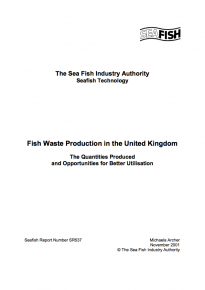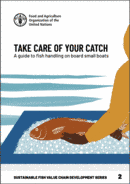Regulatory Environment for Processing Plants
Legislation can be related to the way in which waste is handled and disposed of, food safety concerns related to incorporating animal waste into animal feeds, the environmental impact of waste disposal and financial disincentives that encourage utilization and recycling rather than landfill disposal. Examples of legislation which influences food loss and waste (FLW) decision making by retailers are included below.
The EU Animal By-Products Regulation (ABPR) (1774/2002)
The EU Animal By-Products Regulation (ABPR) (1774/2002) regulates the processing and disposal of products derived from animals and, in particular, prevent material from animals not fit for human consumption from entering the feed chain. ABPR prohibits the disposal of uncooked or untreated fish products to landfill, and retailers have therefore have had to adopt methods which are ABPR compliant such as rendering, with material also used in production of pet food. Rendering will generate protein meal and an oil component both of which may be used in a range of applications.
The UK Food Hygiene (Fishery Products & Live Shellfish) (Hygiene) Regulations 1998
In the UK the disposal of waste, particularly food waste, is strictly regulated. The Food Hygiene (Fishery Products & Live Shellfish) (Hygiene) Regulations 1998 sets out the conditions under which fish and shellfish products must be produced in order to be placed on the market. This includes requirements for hygienic waste handling and disposal. Offal/viscera should be kept separate from products intended for human consumption. On-shore processing facilities must regularly remove waste from the processing area, either by continuous means or by holding the material in leak-proof, covered containers which should be removed when full. Containers for holding waste material must be watertight and corrosion resistant and should be designed to facilitate cleaning and disinfection. If waste material is to be stored overnight, it should be housed in a dedicated waste holding area.
The EU Animal By-Products Regulations (ABPR)
If you dispose of dead fish or shellfish or animal waste from culling or on-site processing of fish or shellfish, you must meet the requirements of the Animal By-Products Regulations (ABPR). These regulations control collection, transport, storage, handling, processing, use and disposal of animal carcasses or parts of animal carcasses.
The UK Environmental Protection Act 1990
The UK Environmental Protection Act 1990 prohibits the keeping, treatment or disposal of waste on land unless a waste management license has been granted for the purpose. It also places a duty of care onto businesses to dispose of waste correctly via an authorized waste transport operator or by taking it directly to an authorized place of disposal. There are documentation requirements associated with this.
The UK Landfill Tax Regulations
The UK Landfill Tax Regulations became effective in 1996 and levy charges on waste deposited in landfill sites. The objectives of the tax are to encourage waste producers to minimize the volume of waste generated, reduce the amount deposited in landfills and to encourage recycling.
The Alaska Solid Waste Program
The Alaska Solid Waste Program
In Alaska, the Solid Waste Program allows three methods for managing commercial fish waste on land:
- Landfill Disposal: Commercial fish waste may be disposed in a permitted landfill willing to accept it.
- Land Application: Fish waste may be ground and tilled into agricultural or silvicultural land as fertilizer, provided the waste is processed and treated as prescribed in the solid waste regulations.
- Composting: Fish waste can be composted to create a usable product. Several successful composting projects have been operated in Alaska.
Depending on the volume of waste involved, a composting operation may require a solid waste treatment permit or plan approval.
Commercial fish waste placed on land must be carefully managed to minimize pathogens, odours, animal attraction, and contamination of water resources. Improper management of fish waste can attract wildlife and pose a serious risk to health, safety, and the environment.
Key Publications
Overview of animal by products and links to relevant EU legislation and information. | |
The report estimates the types and quantities of fish waste generated in the different sectors, from catching to processing, and summarizes the current utilization or disposal of that waste. | |
Environmental guidance for your business in Northern Ireland & Scotland Legislation guidance and links. |
More Resources
More Resources
31 October 2023














